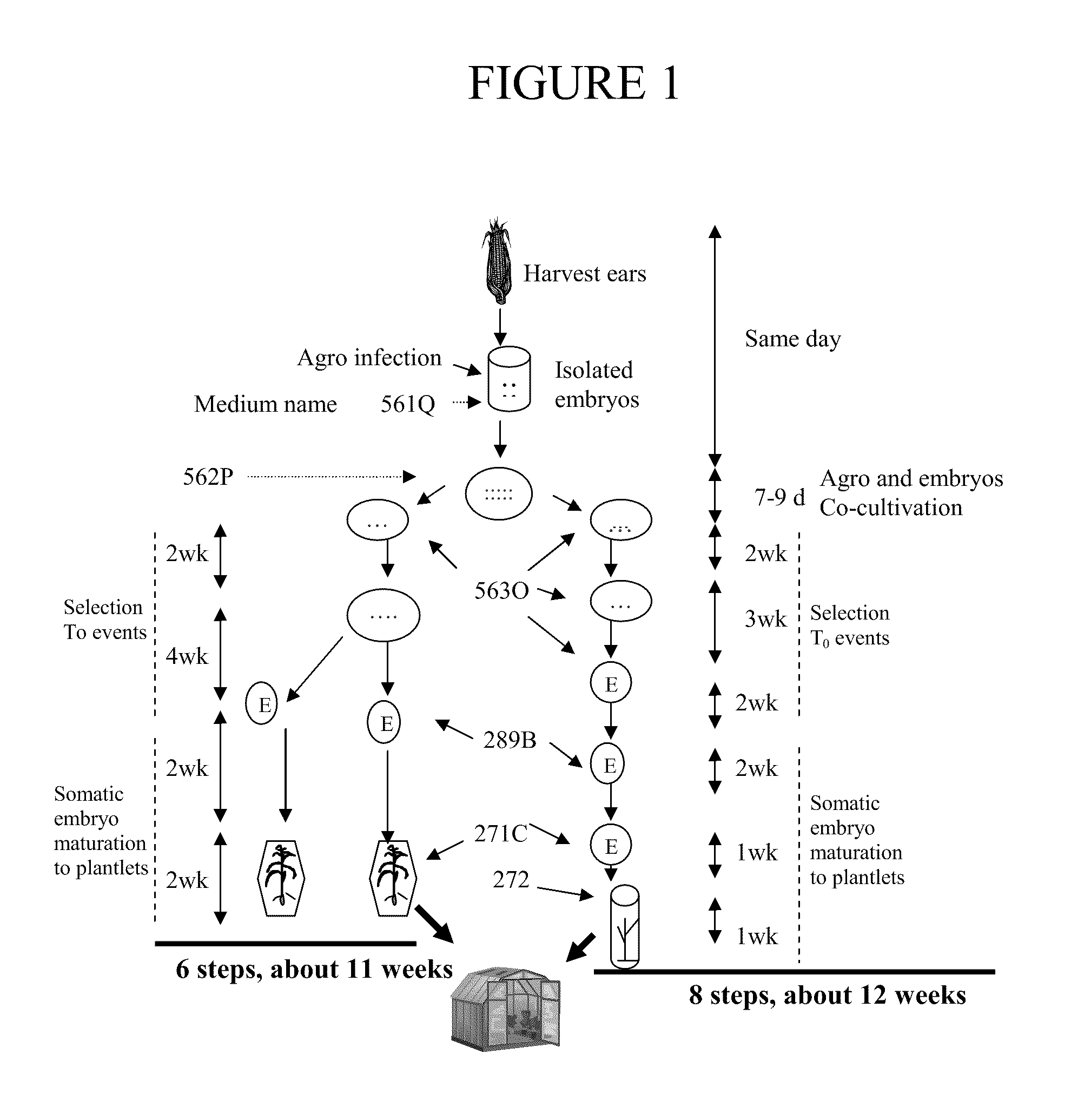Increasing time-efficiency of high-throughput transformation processes
a high-throughput, time-efficient technology, applied in the field of biotechnology, can solve the problems that the regeneration of intact plants from transformed tissue is not always an easy task, and achieve the effect of efficiently transforming immature maize embryos
- Summary
- Abstract
- Description
- Claims
- Application Information
AI Technical Summary
Benefits of technology
Problems solved by technology
Method used
Image
Examples
example 1
Standard Media
[0088]Any transformation method and standard media can be used. The following is an exemplary set of media and protocols.
TABLE 2Composition of media used:MediaComposition (Unit Volume = 1 L)561Q4.0 g Chu(N6) basal salts, 1 mL Eriksson's vitamins 1000X, 0.5 mg thiamineHCl, 1.5 mg 2,4-D, 0.69 g L-proline, 68.5 g sucrose, 36 g glucose, pH 5.2562P4.0 g Chu(N6) basal salts, 1 mL Eriksson's vitamins 1000X, 0.5 mg thiamineHCl, 2.0 mg 2,4-D, 0.69 g L-proline, 30 g sucrose, 0.85 mg silver nitrate, 1 mLacetosyringone at 100 mM, 3.0 g Gelrite, pH 5.8563O4.0 g Chu(N6) basal salts, 1 mL Eriksson's vitamins 1000X, 0.5 mg thiamineHCl, 1.5 mg 2,4-D, 0.69 g L-proline, 30 g sucrose, 0.5 g MES buffer, 0.85 mgsilver nitrate, 3 mg Bialaphos, 100 mg carbenicillin, 8.0 g agar, pH 5.8289B4.3 g MS basal salt mixture, 1 g myo-inositol, 0.5 mg nicotinic acid, 0.1 mgthiamine•HCl, 0.5 mg pyridoxine•HCl, 2 mg glycine, 0.5 mg zeatin, 1 mg IAAat 0.5 mg / mL, 1 mL ABA at 0.1 mM, 1.5 mg Bialophos, 100 mg...
example 2
One Embodiment of an Agrobacterium Transformation Protocol of GS3 & GS3XGaspe with PAT Selection that Typically Uses 6 Steps and Lasts about 11 Weeks to Obtain T0 Plants from Embryos
Isolation of Fresh Embryos
[0089]1. Ears are harvested when the embryo size reaches 1.0-2.0 mm. The ear source are from GH (Johnston Greenhouse) or SH (Johnston an open field covered by screen) or GC (growth chamber of Conviron-BDW120).[0090]2. Sterilize the ears with a 20%-30% bleach solution made with diH2O adding 2-4 drops of Tween 20, for 20 minutes (no longer than 30 minutes). Drain the solution from each container and rinse three times with sterile diH2O[0091]3. Add 2 mL of 561Q medium into a sterile 2 mL microcentrifuge tube for embryo isolation. Label the tops and sides of the microcentrifuge tubes if needed.[0092]4. Dissect embryos from an ear and drop them into a microcentrifuge tube containing 561Q.
Preparation of Agrobacterium Suspension for Agroinfection
[0093]5. Agrobacterium master plate: Pic...
example 3
One Embodiment of an Agrobacterium Transformation Protocol of GS3 & GS3XGaspe with PAT Selection that Typically Uses 8 Steps and Lasts about 12 Weeks
Isolation of Fresh Embryos
[0112]1. Ears are harvested when the embryo size reaches 1.0-2.0 mm. The ear source are from GH (Johnston Greenhouse) or SH (Johnston an open field covered by screen) or GC (growth chamber of Conviron-BDW120).[0113]2. Sterilize the ears with a 20%-30% bleach solution made with diH2O adding 2-4 drops of Tween 20, for 20 minutes (no longer than 30 minutes). Drain the solution from each container and rinse three times with sterile diH2O[0114]3. Add 2 mL of 561Q medium into a sterile 2 mL microcentrifuge tube for embryo isolation. Label the tops and sides of the microcentrifuge tubes if needed.[0115]4. Dissect embryos from an ear and drop them into a microcentrifuge tube containing 561Q.
Preparation of Agrobacterium Suspension for Agroinfection
[0116]5. Agrobacterium master plate: Pick up frozen Agrobacterium (−80° C...
PUM
| Property | Measurement | Unit |
|---|---|---|
| Time | aaaaa | aaaaa |
| Time | aaaaa | aaaaa |
| Time | aaaaa | aaaaa |
Abstract
Description
Claims
Application Information
 Login to View More
Login to View More - R&D Engineer
- R&D Manager
- IP Professional
- Industry Leading Data Capabilities
- Powerful AI technology
- Patent DNA Extraction
Browse by: Latest US Patents, China's latest patents, Technical Efficacy Thesaurus, Application Domain, Technology Topic, Popular Technical Reports.
© 2024 PatSnap. All rights reserved.Legal|Privacy policy|Modern Slavery Act Transparency Statement|Sitemap|About US| Contact US: help@patsnap.com










